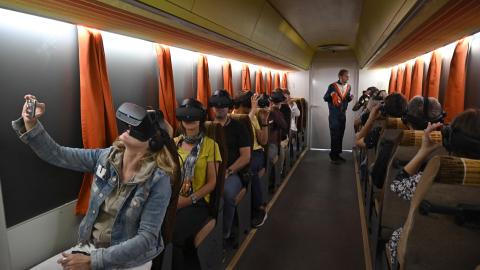Virtual reality tourism can boost travel in a post-pandemic world

TOBIAS SCHWARZ/AFP via Getty Images
- The COVID-19 pandemic has upended the travel and tourism industries;
- Businesses in this sector must build infrastructure and practices that allow people to travel safely in a post-pandemic world and support local communities that benefit from tourism;
- Augmented, virtual and mixed reality technologies can offer alternative ways to travel the world and an exciting new model for the industry.
The tourism industry has hit a nadir owing to the COVID-19 pandemic. It will continue to feel the effects for at least the first three quarters of 2021 – according to a recent UN report, tourist arrivals globally in January 2021 were down 87% when compared to January 2020.
Travel will prevail over post-pandemic anxiety, making it incumbent on the aviation and tourism industry to build safer infrastructure and practices that take care of travellers’ well being.
After a year thwarted by the pandemic and with the future not looking too upbeat for the industry at this juncture, tourism business owners should look at alternative modes of interaction for holidaymakers that can also aid the people and economies who depend on tourism.
The COVID-19 pandemic has noticeably hastened the testing and rollout of forward-looking technologies. Technology has not only enabled citizens globally to interact with loved ones, but also helped industries such as healthcare, information technology, education and many more to work remotely.

In the last few decades, technology has helped travel and tourism industries increase their reach through travel booking websites, videos, blogs and travel photography. Digital tools and content are a vital source of information for vacationists organizing their next holiday or creating a destination wish list. Whilst remote or virtual tourism has been a futuristic theme within industry forums for some time, the world today, shaped by the COVID-19 pandemic, might now be ready to accept it.
A human-centric design that draws insights from cognitive behaviour, social psychology, neuroscience and behavioural economics applied with cutting edge technologies such as augmented, virtual or mixed reality (AR, VR, MR) could be a game-changer. AR, VR and MR can enable a seamless, uninterrupted interactive experience for viewers from their own private space. The design principles will create a frictionless digital user experience and construct a positive perception of a tourist destination.

There have been previous attempts to achieve this feat: if you are an aqua sightseer, you might be aware of a documentary exploring the Great Barrier Reef. Through an interactive website, one can view the clear, tranquil currents of the Pacific Ocean and the biodiversity of the reef, and experience the sounds of a healthy coral reef. Another much-discussed VR experience is Mission 828 which allows you to take a virtual parachute jump from the world’s tallest building, Burj Khalifa in Dubai. The Official Tourist Board of the Faroe Islands has also crafted a virtual experience to entice post-pandemic visitors from across the world.
Imagine a human-centric designed, interactive space online that makes a destination accessible and so real for a sightseer with sound captured by electro-acoustics researchers. You could view holiday sites in a video or through self-navigation using voice or joystick controls, interact with people using video-calling platforms, travel through the streets of said location, eavesdrop on local music and much more. This could be stitched together in a single platform individually or in silos on the internet and further enhanced by setting up physical experience tourism centres locally. Such a setup would allow tourist guides, artisans, craftspeople, hoteliers and transport business to create their own digital and virtual offerings and interact with possible customers.
Here’s how it might look: a vacationer starts their experience from the time their flight commences. The plane descends to the destination runway and pictures of the vicinity from the aircraft window pane are captured. The airport signage welcomes passengers and directs them to a pre-booked taxi. The vacationer gets to choose their first destination and travels through the streets in a chauffeur-driven car whose interactions en route become part of their cherished memories. On arrival, a tourist guide walks you through the destination all controlled with just a tap on your gadget. During the sightseeing, you hear random people speaking, posing for photographs and more. You take a photo to post on social media, go shopping and negotiate with a local vendor to purchase an artwork and get it delivered to your door. You learn how a local dish is prepared and get familiar with local customs.
A virtual platform could even provide an opportunity for people to explore areas that are affected by or fighting terrorism. For example, imagine seeing the diverse wildlife and snow leopard of the Gurez Valley, in the union territory of Jammu and Kashmir, India. It doesn’t stop there: if thought through, one could experience travelling to the South Pole, space and beyond. It could also serve as a learning portal for students to understand geographies, culture, art and history.
With technology improving lives globally, virtual tourism could reignite the tourism industry and its people and help build a more sustainable economic model. As a human-centric platform, it can establish local tourist guides, artisans and others as global citizens in the tourism industry.
Reprinted with permission of the World Economic Forum. Read the original article.





